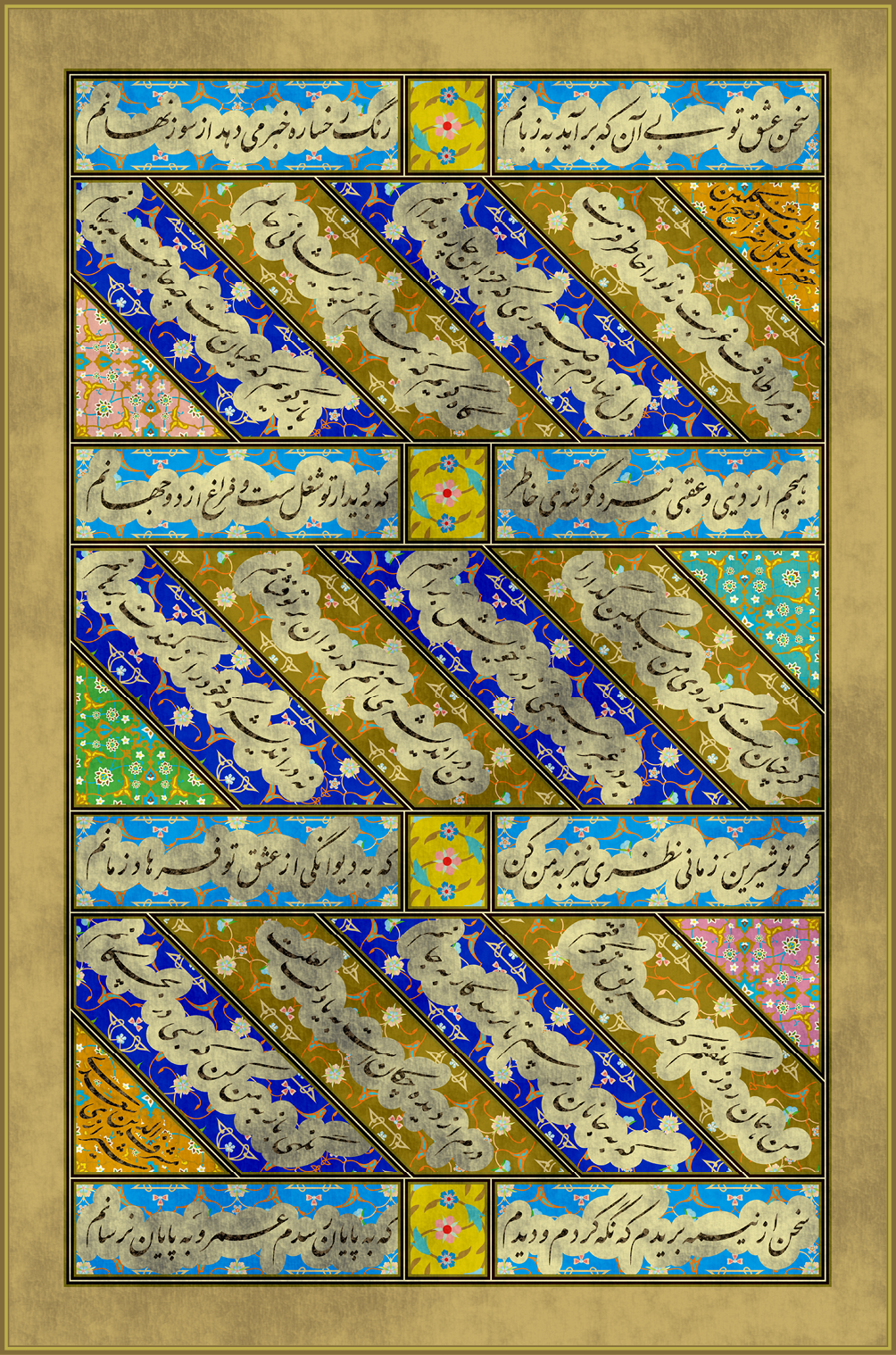The captivating beauty of Persian poetry is still looking for new ways to reveal its hidden thoughts, as if it wants to capture more hearts and minds with its amazing beauty.
The ‘Aliha Gallery’ has exhibited a unique collection of the most delightful works of Persian poetry designed by ‘Hamidreza Bakhtiarifard’ (Professor at the University of Art) from Friday, February 16th, to Thursday, February 22nd, 2024 (the opening ceremony will be held on Friday, February 16th at 4 PM). The title of this exhibition is ‘Booye Jooye Mulyan’ (Smell of Mulyan Stream), a beautiful and famous poem by ‘Rudaki Samarkandi’. According to historical narratives, this poem was written for ‘Amir Nasr bin Ahmed Samani’ to return from ‘Herat’ to ‘Bukhara’. ‘Mulyan’ is the name of a small stream in ‘Bukhara’, where the emirs of ‘Bukhara’ used to spend their time in the past.
Leaving an indelible mark on the landscape of tomorrow.

The revitalized art gallery is set to redefine cultural landscape.
Digital art has been especially influential in Iranian art. From intricate carpet designs to the breathtaking elegance of Iranian painting, pure colors, intricate motifs and deep symbols have all found a new place in the realm of digital art. The extraordinary power of digital art has made it possible to recreate and display the enchanting complexities of Iranian art so that its charm and timeless beauty are more accessible to everyone.
The style and context of the exhibited works are close to the original works of Safavid art. Although these works are made with digital techniques, they show the purest and most exquisite visual space possible that can be seen in Iranian works. The dimensions of each work are 60 x 90 cm and include a six-color printing process on canvas with excellent quality. The combination of Iranian colors has given them a stunning beauty, this richness and color density cannot be seen even in the old masterpieces of Iranian calligraphy and gilding.
The remarkable and relatively large size and vibrant colors make them stand out well on the walls. These works are old and will not be destroyed. They do not require huge expenses for maintenance and special care. Therefore, they are very suitable and affordable for decorating and giving identity to public and private architectural spaces. Also, the very thought-provoking content of the ancient Persian poetry of these works has created the original Iranian historical cultural identity.
On the other hand, the very thought-provoking content of ancient Persian poetry has created a very spiritual atmosphere in these works, which has a double and endless value.

Statment
The Persian language is the main and arguably the most important indicator of Iranian identity, and poetry in Persian is the most prominent level of Persian discourse, which includes Iranian philosophy and wisdom. From the perspective of discourse theory, the main source of production of valuable meaning and gem of Iranian identity is literature, especially Persian poetry, and is associated with the “theory of imaginary societies”. Benedict Anderson (1936-2015) tried to describe. From this perspective, the statement of Javad Tabataba’i (1945-2023) by the author of “Iranshahri Thought Theory” should be considered correct and serious that philosophy in Iran has weakened since the 5th century AH and, with the growth of the powerful Persian poetry tree, gradually out of the field of theoretical discussions and joined the fantasies and poetic images.
The author of these lines emphasizes that the exhibited works have two sides, “visible” and “invisible.” On the visible side, the viewer is watching a number of masterpieces of Persian literature written by poets of different eras, decorated and displayed with colors and motifs. On the invisible side, by watching each task, the reading is made that leads to a particular concept that is carved into the viewer’s mind. This particular concept leads to the reproduction of meaning، which is produced by the links of that invisible chain that binds Iranians together and has made Iran sustainable.
In other words, it is an Iranian discourse and a shared Iranian secret،, and it has existed throughout all periods of history and has always been a reflection of their situation.
Some of the works
‘Rudaki Samarkandi’ (858-941), ‘Hasan Ghaznavi’ (1141-1170), ‘Attar Neishabouri’ (1145-1221), ‘Jalal Al-din Muhammad Rumi (Balkhi)’ (1207-1273), ‘Saadi Shirazi’ (1209-1292), ‘Fakhre Al-din Iraqi’ (1213-1289), ‘Hafez Shirazi’ (1310-1337), ‘ShahNimatullah Wali’ (1330-1431), ‘Abd Al-Rahman Jami’ (1414-1492), ‘Khiali Bukharai’ (Died:1446), ‘Helali Jagatai’ (1470-1529), ‘Saib Tabrizi’ (1592-1676), and ‘Hazin Lahiji’ (1692-1766) are among the poets whose poems have been used in these works.

Abd Al-Rahman Jami
(1414-1492)

Jalal Al-din Muhammad Balkhi
(1207-1273)

Saadi Shirazi
(1209-1292)

Khiali Bukharai
(Died:1446)
FAQs
Persian poetry can be compared to old wine, the drinking of which takes the human mind beyond normal perception and leads to the understanding of the sublime world of love. This beautiful heritage of Iranian culture is a source of inspiration and peace for all those who are fascinated by its beauty.
Persian language is one of the most important ancient languages of the world, and poetry is of great value and importance in the Persian language, to the extent that there may not be any Persian philosopher, scholar and sage who are not poets throughout history. Zoroaster, the true prophet of Iran, ‘Avicenna’, the famous physician and philosopher, and the great astronomer and mathematician ‘Omar Khayyam’, have expressed many of their thoughts in the form of poetry, as if poetry is the quintessence of Persian language and prose is in a lower level in terms of importance. Therefore, it should not be surprised to hear the fact that: The most well-known works of Persian literature, such as ‘Shahnameh’, ‘Masnavi’ and even ‘Avesta’ written in ancient Persian has a poetic format. Persian poetry is full of beautiful and excellent literary metaphors. Perhaps, Persian poetry can be compared to old wine, the drinking of which takes the human mind beyond normal perception and leads to the understanding of the sublime world of love. This beautiful heritage of Iranian culture is a source of inspiration and peace for all those who are fascinated by its beauty. However, the captivating beauty of Persian poetry is still looking for new ways to reveal its hidden thoughts, as if it wants to capture more hearts and minds with its amazing beauty. Today, digital art with its impressive power has created many opportunities for artists.
- ‘Rudaki Samarkandi’ (858-941)
- ‘Hasan Ghaznavi’ (1141-1170)
- ‘Attar Neishabouri’ (1145-1221)
- ‘Rumi (Balkhi)’ (1207-1273)
- ‘Saadi Shirazi’ (1209-1292)
- ‘Fakhre Al-din Iraqi’ (1213-1289)
- ‘Hafez Shirazi’ (1310-1379)
- ‘ShahNimatullah Wali’ (1330-1431)
- ‘Abd Al-Rahman Jami’ (1414-1492)
- ‘Khiali Bukharai’ (Died:1446)
- ‘Helali Jagatai’ (1470-1529)
- ‘Saib Tabrizi’ (1592-1676)
- ‘Hazin Lahiji’ (1692-1766)

